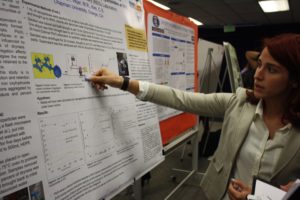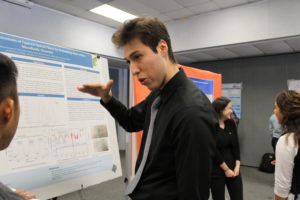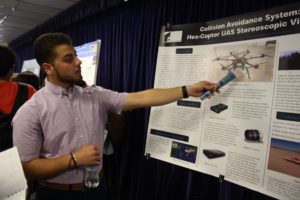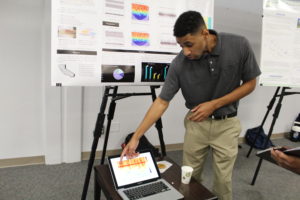Walls were broken down at the Fifth Annual STEM Research Symposium in the Citrus College Handy Campus Center.
The campus center began to get stuffy as over 300 observers came to see students’ results from Citrus’ Summer Research Program.
To bring in some fresh air, directors took down the collapsible wall that divides the room.
Erika Hermosillo’s poster was taped to the removable dividers and accidentally came loose when the wall was removed.
The poster now hung like a flag. Quick to adapt, she readjusted her poster and began to explain the methods of her research.
Her group was the first to use a new device called a spray tower to inoculate test subjects in order to create better pesticides. She used the model organism Drosophila melanogaster, also known as fruit flies as her test subjects.
While she produced results, she had a feeling things could still be improved.
We found out that the nozzle wasn’t adequately cleaned between runs, so that’s something we can fix in later experiments, Hermosillo said.
At its heart, science is about experimenting and constant improvement and revision of what we know.
“I got to be at the beginning of something,” Hermosillo said.
Hermosillo is one of 50 Citrus College STEM undergrads who worked full-time in labs this summer.
The STEM program teams up with local research groups to provide motivated students with an opportunity to learn and apply new research skills while studying current technologies.
The Citrus College Summer Research Experience, which started five years ago, is a program where students perform mentored research full-time for two months.
The students get hands-on experience in the professional scientific process, including receiving a stipend, and share and explain their results.
Citrus students conducted research at Oak Crest Institute of Science, City of Hope, Jet Propulsion Laboratory, Chapman University, Cal Poly Pomona, Rancho Santa Ana Botanic Garden, Cal State University Fullerton, and Keck Graduate Institute.
“Our students are amazing. They are able to talk about their research in such profound ways,” Smith said.
Breaking Walls

Maria Diaz performed research this summer on nanoparticles that may be able to clean lead from the environment. Diaz researched at Chapman University.
The former cosmetologist has been fascinated with hair, and always had an interest in the products used to color and style hair.
Her experience in research this summer has given her a better perspective on the science involved.
She now plans on studying chemical engineering.
“Before this, I only had a vague idea of what research is,” Diaz said. “It was a lot of little victories, a lot of failures. Sometimes it made me want to pull my hair out, but at the end of the day, it’s what I love.”
This Is Only A Test

Matthew Gonzalez completed his second year of the Citrus Summer Research Experience.
He performed research this summer at on strengthening optical fibers which can be used with very small amounts of liquid, such as in DNA analysis. Gonzalez researched at Cal Poly Pomona.
During surgery, these channels can detect small changes of things in the bloodstream, which doctors can respond to, Gonzalez said.
“I loved it,” Gonzalez said. “I’m a team kind of guy.”
I got to be independent, and learned how to manage my time, Gonzalez said.
Gonzalez enjoyed the autonomy, and was able to contribute concepts to the research project.
The doctor likes input, and he used my idea,” he said. “That feels really good.”
Eye Safety

Basel Chahla, Mech Engineering, studied Collision Avoidance Systems at Cal Poly Pomona.
An unmanned aerial system, or UAS, is commonly known as a drone or UAV.
Chadha’s group used stereoscopic vision in the form of two high-tech “eyes,” which combine data to make an image that senses distance.
When their 3D printer stopped working, his team improvised and continued with their experiment using a low-tech method to achieve similar results.
A piece of wood and duct tape worked just as well to mount the cameras, and Chadha was able to produce an image that combines the data from both cameras to detect how far of objects are.
Detecting and avoiding possible collisions can protect unmanned vehicles from costly accidents.
Pure Mathematics

Ryan Jourdain conducted all his research without needing to perform an experiment.
Instead, he used existing, published data dating back over a hundred years to track trends in weather.
He performed statistical analysis using computer code to remove known seasonal changes in weather. After that, only deeper, less obvious trends could be observed.
There is a wealth of data available that may provide valuable information about the world.
If data can be cleaned up and analyzed using clever coding and rigorous analysis, there may be trends that we have not seen yet, and can be used to predict events in the future.
His research aims to create better models that can predict the timing of El Niño with more accuracy.
Jourdain’s code is open to the public and can be found at www.github.com/rjjourdain.
Reaching out to the stars
Nestor Aquino researched star formation in the Milky Way Galaxy at Cal Poly Pomona.
Aquino is in charge of Alis, Citrus College’s research and arts journal. Alis features original work created by students at Citrus College. Alis’ website can be found at citrusalis.weebly.com, and is looking for students to submit their research, short stories, poetry and fine art. Submission deadline is November 7, 2016.
More information about the Citrus STEM program, including directions for aspiring applicants can be found here: Summer Research Page


